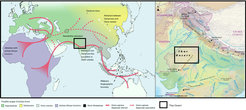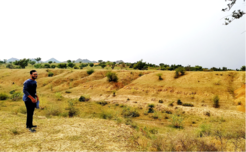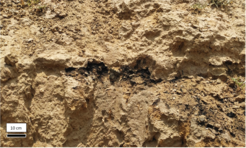Reconstruction of Climate, Vegetation and Fire Across Palaeolithic Transitions in the Indian Subcontinent
The Indian subcontinent occupies a key geographic location as it is at the southern mid-point of Asia. With respect to human evolutionary studies, the subcontinent deserves consideration as a critical area for exploring hominin dispersal processes, particularly the migration of Homo sapiens during the Late Pleistocene. During the Middle and Late Pleistocene, there is emerging archaeological evidence for major technological transitions, changes in cultural adaptations, and varying settlement and subsistence patterns. Unfortunately, the climatic and environmental contexts of these cultural shifts remain poorly understood. In this project, we use a multi-disciplinary multi-site (MDMS) approach to discern how changing global and regional climate impacted hominin-relevant ecosystems across the Indian subcontinent.
It has been repeatedly postulated that the global Quaternary climate has had major consequences for the distribution and behaviours of Homo species through time. The diverse environments of India would have posed variable challenges and opportunities for hominin populations – from tropical rainforests to arid deserts. However, ‘on-site’ palaeoclimate and palaeoenvironmental records, with which to explore the impacts of climate changes on different Indian ecosystems, and their hominin inhabitants remain scarce.

Fossilised hominin remains are absent for much of the Middle and Late Pleistocene on the Indian subcontinent, meaning that archaeological sedimentary sequences are primarily dominated by stone tools. The Quaternary sedimentary sequences have preserved the multiple transitions in stone tool technology and connected behaviours. One of the most prominent technological transitions is from the Lower to the Middle Palaeolithic, occurring during the Middle Pleistocene. The reason for this major technological shift, with the adoption of new toolkits, remains unclear. We will investigate the role of Quaternary environments in conditioning hominin behaviour, and examine if refugia played a role in supporting populations over the long term.

The controlled use of fire is one of the most significant cultural innovations in human evolution, which enhanced the ability of hominins to survive and occupy new ecological and behavioural niches. To date, the earliest reported use of fire in the Indian subcontinent is during the Middle Palaeolithic, recently reported from the Belan valley, northern India (Jha et al., 2021). The evidence of fire was established through analysis of macroscopic charcoal particles in cultural layers. However, such records are fragmented and need multi-proxy investigations to better understand fire-use and its role in hominin behaviour.

The MDMS project will seek to obtain novel information about the environments that hominins were occupying in India, allowing us to examine technological and behavioural changes. A range of multi-proxy palaeoenvironmental analyses will be conducted, including bulk isotopic analysis of soil organic matter (δ13C and δ15N values), compound-specific isotopic analysis (δ13C and δD values) of extracted leaf waxes, and soil carbonate isotopic analysis (δ13C and δ18O values). Palaeofire activities will be investigated using the extraction of macroscopic charcoal particles and Polycyclic Aromatic Hydrocarbons (PAHs) from sediments collected from the archaeological sites preserved in different parts of the Indian subcontinent.
Related Publications
Jha, D.K., Samrat, R., Sanyal, P. 2021. The first evidence of controlled use of fire by prehistoric humans during the Middle Paleolithic phase from the Indian subcontinent. Palaeogeography, Palaeoclimatology, Palaeoecology. 562, p.110151.
Jha, D.K., Sanyal, P. and Philippe, A. 2020. Multi-proxy evidence of Late Quaternary climate and vegetational history of north-central India: Implication for the Paleolithic to Neolithic phases. Quaternary Science Reviews, 229, p.106121.


